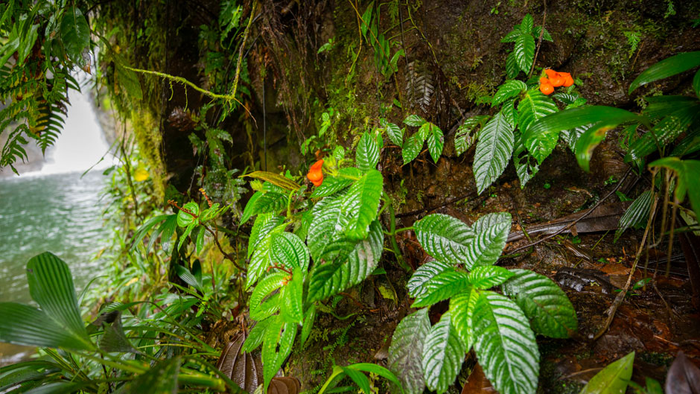Scientists rediscover tropical plant species thought to be extinct for almost 40 years
Small expedition came across South American wildflower after setting off in November to Centinela Ridge in western Ecuador, reports Emily Atkinson

Scientists say they have rediscovered a tropical plant species believed to be extinct for almost 40 years.
A team of researchers set off on a small expedition in November to the Centinela Ridge in western Ecuador, famed among biologists for being the home to a plethora of rare species.
They went in search of the low-lying Gasteranthus extinctus, a South American wildflower discovered in the 1980s, so named in the 2000s as it was believed by scientists to be extinct since many of the forests where it was located had become teak, cacao, or banana plantations.
In order to determine whether the species was really extinct, botanists Nigel Pitman and Dawson White from Chicago’s Field Museum assembled an international team of plant scientists, including several Ecuadorean botanists.
As soon as they landed in Centinela, the experts were divided into three groups to comb the few remaining forest patches they had previously mapped using satellite images.
Among them was graduate student Riley Fortier, who was encouraged to join the search for Gasteranthus extinctus by his adviser and biology associate professor Kenneth Feeley.
“Almost immediately, two of the teams found the plant growing along streams,” said Mr Fortier.
“We were definitely excited to see it, and because of how bright the flowers are, once we knew what to look for, it was easy to find.”
Tweeting a photo of their discovery, Mr Pitman said: “And suddenly there it was. Not gone. Not at all extinct. Still alive and well and capable of catching your eye from halfway across the forest.
“Sharp-eyed young botanist @JNicoZapataB spotted it first. We all keyed it out together. And we haven’t stopped smiling since.”
The distinctive plant was also found by the team growing outside of the Centinela Ridge, revealing that it was not limited to the initial, small area.
“This is a call for optimism – it shows that some of these species that we thought were extinct are not, and that these little patches of forest that are left behind can help save the diversity of plants and animals in this area,” said Mr Feeley, the University’s Smathers Chair of Tropical Tree Biology and a co-author of the article.
“Some of these species have been able to hang on for a long time, but that area is still losing forest as they continue to clear it for agricultural land, so we need to save what we have now to prevent any actual extinctions.”
Ecuador is regarded as one of the most diverse countries in the world, home to 17 per cent of the world’s bird species and 16,000 different plants, according to the World Land Trust.
Centinela Ridge, located in the nation’s northwest, lies just west of the Andes, between the mountain range and the Pacific Coast.
Its remoteness is perhaps the reason it contains hundreds of endemic tropical species.
An ongoing collaboration between Mr Feeley and Mr Pitman paved the way for the rediscovery of Gasteranthus extinctus and the pair are currently working to understand the extinction risk of many tropical plant species.
Mr Feeley, who studies the effects of climate change on tropical plant and tree communities, said he hopes that this expedition will spark others to explore the remaining forests and discover what other tropical species may or may not be extinct today.
“This highlights a problem of the tropics, which is that we have so little information; until you send a team of top botanists to a location, you’ll never know what is really there,” he said.
“The fact that we can’t even be confident about if a species is either alive or extinct just highlights that we need more people out there looking for these species.”
Mr Feeley and Mr Pitman hope the expedition to the Centinela Ridge will not be the last.
The team of botanists is now working with local organisations to protect the two remaining patches of forest that exist in the area.
Mr Fortier said that these two spots represent just 100 hectares of land – about 247 acres – but contain a host of rare plant species, such as Gasteranthus extinctus, as well as many insects, birds, and mammals.
While there, Mr Fortier said he was glad to see howler monkeys inhabiting the trees.
“Right now, these forests could be cut down any day, so we want to push to protect them,” he said.
As part of the solution, conservation groups or the Ecuadorian government must buy the land in between these forests and connect them through restoration efforts, Mr Feeley added. Additional funds and resources are also needed so that scientists can survey the many tropical species in the region and help protect them from extinction.
“When botanists first collected plants there, they noted the immense biodiversity of the region, but before they could do anything about it, they returned and were completely alarmed by the deforestation,” Mr Feeley said. “Unfortunately, deforestation can happen quicker than science can.”
Both Mr Feeley and Mr Fortier stressed the importance of conserving this diversity to help counter the effects of climate change.
“Preserving biodiversity, especially local biodiversity, is more than just plants and animals. It’s also preserving the water cycle, our food, and much more,” Mr Fortier said. “We are ensuring an easier life for humankind in the long run.”






Join our commenting forum
Join thought-provoking conversations, follow other Independent readers and see their replies
Comments